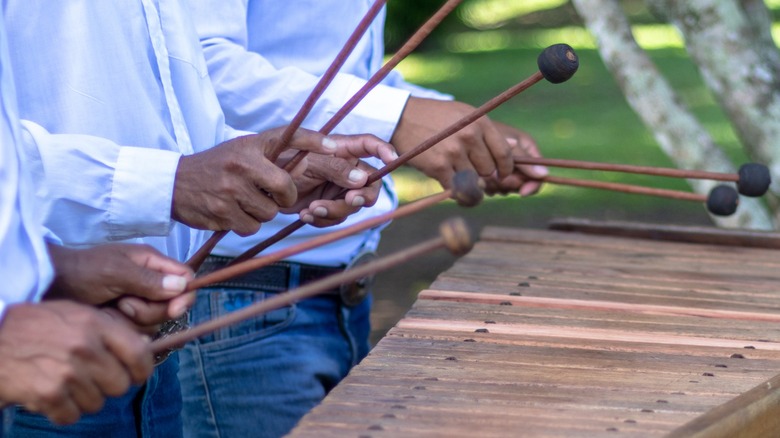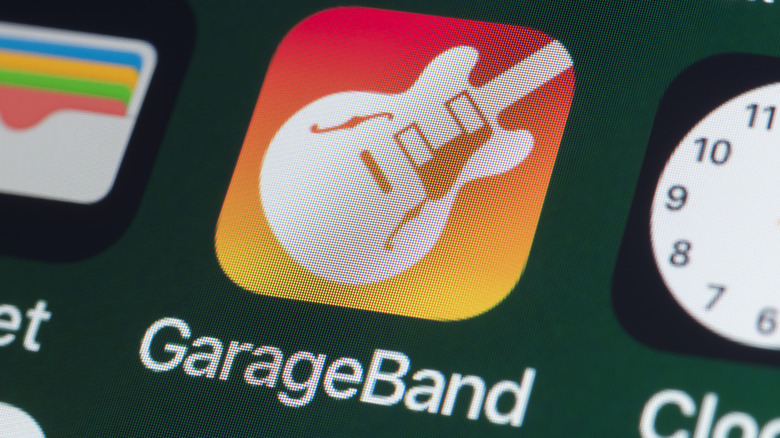The Historical Connection Behind The iPhone's Most Famous Ringtone
While you might stick with a classic ringer or vibration, the iPhone still comes with stock sound effects you can pair to your various notifications. You've got the dog-confusing "Bark," the jaunty swing of "By The Seaside," or the vintage "Old Phone." But none of them sonically scream "iPhone" more than the iconic and simply named "Marimba."
Played on a synthesized version of the titular mallet percussion instrument, the brief tune offers a bright, catchy, pentatonic melody, with friendly chord punches underneath. It's joyful but classy, accessible but impressive. If you hear it, your body will subconsciously tense up in anticipation of a surprise text message or forgotten alarm.
But "Marimba" is no mere piece of Muzak, no dashed-off composition by some lower-rung Apple employee. The history of "Marimba," like many pieces of Apple's history, is far juicier. It all started with a tactical avoidance of a potentially fiery legal battle.
The famous ringtone balanced innovation and comfort
Steve Jobs' original conception of the iPhone ringtones was to allow users to create snippets of songs in their iTunes library. But to pull this off, Apple would've had to jump through all kinds of legal and copyright hoops. They would've had to strike usage deals with the major record labels, the major cellular companies, and the Recording Industry Association of America. The RIAA was in the middle of their own hoop-jumping, figuring out how to legally classify a ringtone with the U.S. Patent and Trademark office.
To avoid this hullabaloo, and keep the iPhone delivery date on track, Jobs pivoted to a self-contained, highly curated, in-house construction of just 25 default ringtones. To help shepherd the iPhone's aural vocabulary, Jobs enlisted Dr. Gerhard Lengeling, Apple's Senior Director of Software Engineering of Musical Applications.
In Jobs' words, Dr. Lengeling was interested in making the sometimes esoteric process of music accessible for "the rest of us," and he was tantamount to Apple's very accessible digital audio workstation GarageBand. Because of this focus on the general populace, Dr. Lengeling was the perfect candidate to determine sounds that split the difference between innovation and comfort.
A simple software instrument changed the world
Where does the actual composition of "Marimba" — the one piece of 25 that became so beloved, even Jobs used it as his default ringer — come from?
Unlike the iconic Nokia ringtone, which was a purposeful interpolation of Francisco Tárrega's "Gran Vals," "Marimba" does not seem to be an excerpt of existing music (corroborated by professional marimba player Nancy Zeltsman). While the nitty-gritty details may be lost to time, there's one credible theory remaining.
In GarageBand, the aforementioned program developed by Dr. Lengeling, there exists a software instrument called "Orchestra Marimba," introduced to the program two years before Jobs' fateful Macworld presentation. This software interpretation of a marimba instrument sounds just about identical to what you hear in the "Marimba" ringtone.
Dr. Lengeling and his music technology team could have developed the "Marimba" piece — a fusion of 21st-century pop art and status signification like none other — using nothing more than GarageBand and a vision. As of now, that is likely the best and most educated guess we've got, but "Marimba's" origins still remains unconfirmed.


